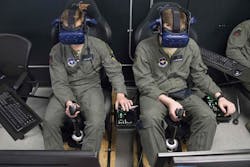The Air Force's virtual reality high-performance jet fighter pilot training works best for 5th-gen pilots
SAN ANTONIO, Texas – U.S. Air Force experts are finding that experimental virtual reality fighter pilot training is working best for students who want to fly the service's most advanced stealth platforms -- though leaders are not exactly sure why. Military.com reports. Continue reading original article
The Military & Aerospace Electronics take:
5 April 2021 -- Maj. Gen. Craig Wills, 19th Air Force commander within Air Education and Training Command, says it appears students who fly the F-22 Raptor and F-35 Joint Strike Fighters are leading in the field of virtual reality training.
The service collects feedback from units that accept graduates from the Pilot Training Next program, which uses virtual and augmented reality technology to train on fundamental aviation skills.
Students tend to do better in F-35 and F-22-type courses compared to how they've done in the fourth-generation fighters, Wills says, adding that he cannot why, but notes that F-15 Eagles or F-16 pilots sometimes see a six-to-seven month break in training as they wait to be assigned to their aircraft following undergraduate pilot training.
Related: The increasing role of COTS in high-fidelity simulation
Related: Simulation and mission rehearsal relies on state-of-the-art computing
John Keller, chief editor
Military & Aerospace Electronics
